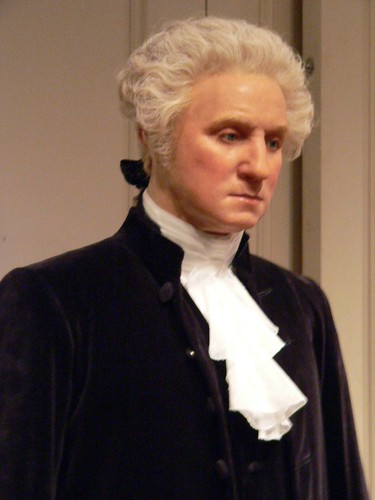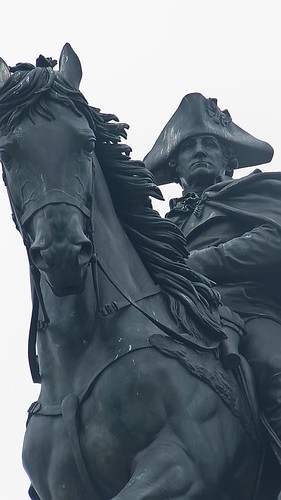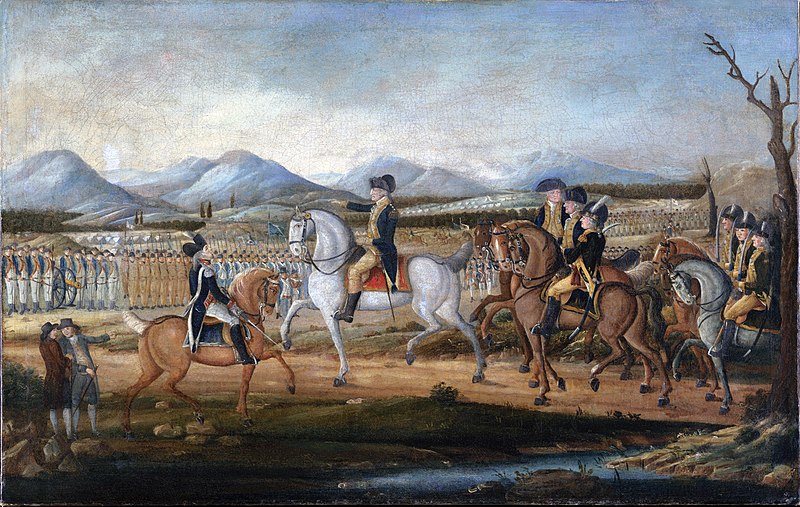
When I was asked to review this new DVD series from the History Channel I thought it would be a collection of biographies of the men that have held the office of President of the United States since George Washington assumed the office on April 30, 1789. Although, it began with George Washington and worked its way through each successive office holder, it quickly became clear to me that the focus of this new 2013 production was directed toward each man's presidential politics and how the policies of each administration ultimately shaped the role of government in its citizens lives and in the world community of nations.
Perhaps the best way to illustrate the difference in this new production is to compare it to an earlier award-winning series produced in 2005 for the History Channel entitled simply "The Presidents" since they appear to cover the same material.
 |
| George Washington sculpted in wax at Madame Tussaud's in London. Photo by Mary Harrsch. |
Of course both series start with George Washington. The 2005 documentary begins by telling us interesting little facts about George Washington, the man. We learn he loved to dance the minuet and collect American landscape paintings. He enjoyed interior decoration, personally decorating the interiors of his home at Mount Vernon. He also dabbled in fashion design and designed various military uniforms. Thomas Jefferson said he was the best horseman he had ever known and Washington's white horse was named Nelson.
We learn Washington was considered a good judge of character and not someone who simply wanted "yes men" advisors. He selected the first cabinet and it was composed of really talented and experienced men including Thomas Jefferson who served as Secretary of State and Alexander Hamilton who became the first Secretary of the Treasury. Washington met with them regularly and seriously considered their advice when making decisions. Then, one of the professional historians interviewed for this segment very tactfully mentioned that Washington was "accustomed to command." We also learn that Washington did not like to shake hands but one of the historians again tactfully explained that Washington simply felt it was beneath the dignity of the office of President.
 |
| An equestrian statue of George Washington by Rudolf Siemering Bronze 1897 CE atop the Washington Monument in Eakins Oval outside the Philadelphia Museum of Art. Photo by Mary Harrsch. |
Interesting what a difference eight years makes in historical perceptions! The new series first spends quite a bit of time explaining the context of the office of president at that time. Congress considers itself the most important governing body and also imparts substantial strength to the judicial branch. But the position of chief executive is viewed as someone who essentially will rubber stamp whatever legislation is ultimately sanctioned by the Congress. Members of Congress did not initially consider giving the president veto power or control of government in any way, wishing to avoid the problems of hereditary monarchies or military-controlled empires.
As the first person to hold the office, Washington set a number precedents, including the appointment of a cabinet. As mentioned in the first series, it is pointed out that he dislikes shaking hands but this time the historian is more frank about Washington's attitude that he felt the custom was beneath him.
The differences between the two documentaries becomes especially obvious in the discussion of Washington's second term. When Great Britain and France declare war and Washington decides to sign a neutrality agreement, people are outraged. Some people call Washington a traitor and Washington is burned in effigy. Furthermore, Congress questions Washington's right to sign such an agreement since the president cannot declare war. That is the perogative of Congress. Washington becomes very angry because he is not only "accustomed to command" as it was so delicately stated in the first documentary, but he is not used to criticism or having his viewpoint challenged.
 |
| George Washington leading 12,000 volunteers to suppress the Whiskey Rebellion. Image courtesy of Wikipedia. |
As the second term wore on, the 2013 program points out Washington became tired of the job and longed to retire to Mount Vernon. He often appeared bored at state dinners.
His selection of the site of the new nation's capital was not without challenge either. Several of the colonies, now states, had incurred large debts during the revolution and wanted the central government to now assume them. Other colonies that had paid their own debts were opposed. Washington felt strongly that if the central government was to exercise authority over all of the states, it should assume the war debts. But to overcome the opposition he developed a compromise. One of the largest debtors was New York, the location of the capital at that time. The majority of colonies that did not have large war debts was in the south. So Washington proposed that in exchange for assuming the war debts of the mostly northern colonies, the new government capital would be relocated south to its present location on the Potomac River. I thought this was an interesting example of early political compromise.
So, I came away from my comparison wishing the History Channel had integrated these documentaries to truly produce an "Ultimate Guide to The Presidents". The 2013 documentary also included more live action reenactments and tack sharp visuals as well as a more dramatic score. At least I can recommend both productions as complementary to each other and not duplicative in scope or focus.
 |
 |

No comments:
Post a Comment